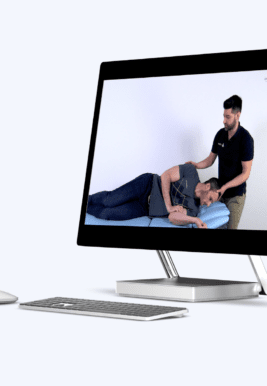Learn
Joint Position Sense Error (JPSE) | Dizziness Assessment
In recent decades, several studies have examined the relationship between proprioceptive deficits and neck pain. Cervical proprioception can be measured using the Joint Position Sense Error abbreviated as JPSE, which reflects a person’s ability to accurately return his head to a predefined target after a cervical movement.
A review by de Vries et al. (2015) has shown that patients with traumatic neck pain had a significantly higher joint position sense error abbreviated as JPSE compared to healthy controls. In patients with non-traumatic neck pain, half of the studies show that patients have an enlarged JPSE.
A study by Treleaven et al. (2003) reports the same results where whiplash patients with dizziness displayed an even greater joint position error than those without dizziness.
According to Roren et al. (2009), laser measurement of the JPSE had substantial test-retest reliability with an ICC of 0.68 in healthy subjects and patients with neck pain. For this reason, the JPSE can be measured with confidence in practice.
To measure the joint position sense, have the patient in sitting position wearing a laser tracker pointing at a target (start position).
The distance from the target to a laser tracker is about 90 cm or 3 feet.
The patient is instructed to close his eyes and turn his head to the right side all the way.
Then the patient is asked to relocate the head back to the starting point. The error is measured with distance at the end point from the start point.
Afterward, the patient opens his eyes, recenters the laser at the bullseye, and closes his eyes again.
Repeat this procedure for at least 6 trials in total.
Afterwards, the same procedure is repeated for a turn to the left, as well as for cervical flexion and extension.
This test is positive for impaired cervical proprioception if the mean error for any direction is larger than 4.5°, which on this target is more than 6cm from the bullseye. This means that for at least half of the trials, the dots can be found outside of the second ring of the target.
It’s important that the patient moves his head in a relatively slow and steady motion. The faster the head moves, the more JPSE represents vestibular afferention rather than cervical afferention that we actually want to measure.
LEARN TO TREAT THE MOST COMMON CAUSE OF VERTIGO IN THIS FREE MINI-VIDEO-SERIES

Next to the joint position sense error, your dizziness exam should include the following assessments:
- Gaze stability
- Saccadic Eye Movement
- Eye-Head Coordination
- Postural Stability
- Smooth Pursuit Neck Torsion Test
- Cervical Torsion Test
- Head-Neck Differentiation Test
References
Like what you’re learning?
BUY THE FULL PHYSIOTUTORS ASSESSMENT BOOK
- 600+ Pages e-Book
- Interactive Content (Direct Video Demonstration, PubMed articles)
- Statistical Values for all Special Tests from the latest research
- Available in 🇬🇧 🇩🇪 🇫🇷 🇪🇸 🇮🇹 🇵🇹 🇹🇷
- And much more!








